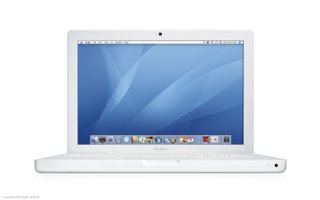
Apple today unveiled the newly designed MacBook, its new consumer notebook featuring the Intel Core Duo processor and a new 13-inch glossy widescreen display. Apple says the new sleek design is up to five times faster than the iBook and up to four times faster than the 12-inch PowerBook. Together with the 15-and 17-inch MacBook Pros, the new MacBook, which starts at $1,099, completes Apple's Intel-based portables lineup and replaces both the iBook and the 12-inch PowerBook. Apple's line of portables now offers Intel Core Duo processors; a built-in iSight video camera for video conferencing on-the-go; Front Row media experience with Apple Remote; and several advanced features including DVI with dual display support, optical digital audio input and output, Gigabit Ethernet, Sudden Motion Sensor, Scrolling TrackPad and MagSafe Power Adapter. Three MacBook models are available--two white models for $1,099 (60GB/Combo) and $1,299 (60GB/SuperDrive) and a black model for $1,499 (80GB/SuperDrive).
"Apple began the transition to Intel Core Duo-based notebooks in February with the 15-inch MacBook Pro, and now just 90 days later we have completed the transition with the release of the all new MacBook," said Philip Schiller, Apple's senior vice president of Worldwide Product Marketing. "The complete MacBook lineup leads the industry with Apple's trademark innovative design and advanced mobile features -- from top to bottom it is the best notebook line that we have ever offered."

The MacBook lineup includes three models: a 1.83GHz and 2.0GHz MacBook in a newly designed, sleek white enclosure and a 2.0GHz MacBook in a new black enclosure. Apple says the new MacBook offers performance up to five times faster than the iBook and up to four times faster than the 12-inch PowerBook with a completely new system architecture including a 667MHz front-side bus and 667MHz DDR2 SDRAM memory expandable to 2GB.
The new MacBook portables are about one-inch thin and 20 percent thinner than the iBook; they feature a new 13-inch glossy widescreen display, which is 79 percent brighter than the iBook and the 12-inch PowerBook and 30 percent larger (1280x800): "the MacBook provides incredibly crisp images with richer colors, deeper blacks and significantly greater contrast."
Every new MacBook comes with a built-in iSight video camera for video conferencing on-the-go using Apple's iChat AV, or recording a video Podcast or iMovie using iLife '06. MacBook also includes Photo Booth, Apple's application that lets users take quick snapshots with the built-in iSight video camera, add entertaining visual effects and share their pictures with the touch of a button.






